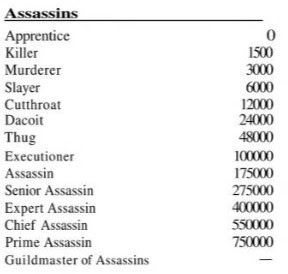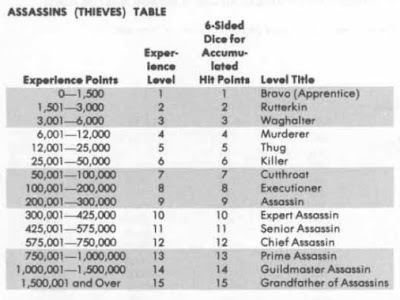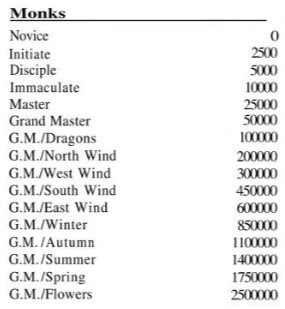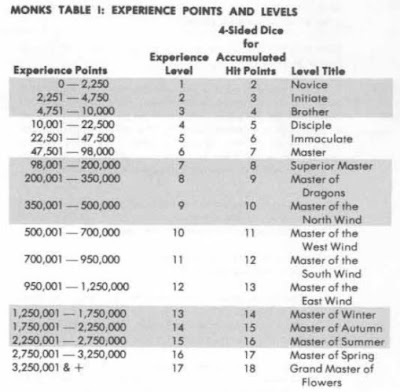Level Titles: Assassins and Monks
To continue with our discussion of level titles in Dungeons & Dragons, I thought it might be worthwhile to take a look at two classes that first appeared in Supplement II to OD&D, Blackmoor (1975), and later in the Advanced D&D Players Handbook (1978) – assassins and monks. Here are the level titles of the former, as they were in Blackmoor:

As with most level titles, these are all mostly synonyms, with a few exceptions, the first being "dacoit," which is an archaic term that, like "thug," ultimately derives from India. Another notable exception is "guildmaster of assassins," which suggests, like the titles immediately before it, that there's some kind of organized structure granting these titles to assassins as they gain experience. The text of Supplement II more or less states this: "Any 12th level assassin (Prime Assassin) may challenge the Guildmaster of the Assassins' Guild to a duel to the death, and if the former is victorious he becomes Guildmaster." This suggests there's a single Assassins' Guild rather several, as seems to be the case with thieves.
Regardless, the assassin level titles in the Players Handbook are somewhat different:
 While many of the low-level titles are identical to those in Blackmoor, their arrangement is changed. In addition, Gygax indulged in his fondness for odd archaisms, like rutterkin and waghalter, while getting rid of "dacoit." Interestingly, he added a new title above "guildmaster assassin," namely, "grandfather of assassins," for reasons both historical and practical.
While many of the low-level titles are identical to those in Blackmoor, their arrangement is changed. In addition, Gygax indulged in his fondness for odd archaisms, like rutterkin and waghalter, while getting rid of "dacoit." Interestingly, he added a new title above "guildmaster assassin," namely, "grandfather of assassins," for reasons both historical and practical.Monks offer an intriguing parallel to assassins, because, like them, their level titles suggest the existence of a single organization that governs them and thus grants these titles. Likewise, above a certain point, the granting of these titles is tied to success in combat against the previous holder of the title, perhaps inspired by martial arts trials. The OD&D level titles are:
 In the AD&D Players Handbook, we get this version of them:
In the AD&D Players Handbook, we get this version of them:
 The AD&D list differs only in inserting an additional level and reserving the title "grand master," as opposed to simply "master" for the highest level. Otherwise, the two lists are almost identical, even down to the progression order of the various master titles (Dragons, North Wind, West Wind, etc.). I find that interesting, but I'm unsure what conclusions, if any, we can draw from these facts. It's also worth noting that, according to some sources, the "master" titles were inspired by the names of mahjong tiles, which seems plausible, given how wide were the interests in games of men like Arneson and Gygax.
The AD&D list differs only in inserting an additional level and reserving the title "grand master," as opposed to simply "master" for the highest level. Otherwise, the two lists are almost identical, even down to the progression order of the various master titles (Dragons, North Wind, West Wind, etc.). I find that interesting, but I'm unsure what conclusions, if any, we can draw from these facts. It's also worth noting that, according to some sources, the "master" titles were inspired by the names of mahjong tiles, which seems plausible, given how wide were the interests in games of men like Arneson and Gygax.
James Maliszewski's Blog
- James Maliszewski's profile
- 3 followers



